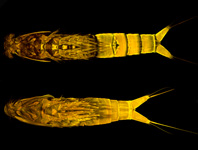Abstract
A survey of copepods from intertidal zone of the Persian Gulf and the Gulf of Oman resulted in discovery of three new species belonging to the family Canuellidae Lang, 1944. This work contributes to the final aim to describe meiobenthic copepods from this region and is the first description of meiobenthic copepods from Iranian coastline. The new species belong to the genera Brianola Monard, 1926, Canuella, T. & A. Scott, 1893, and Scottolana Huys, 2009. Compared to other congeners, Brianola haliensis sp. nov. is unique in the armature of the first leg, number of segments and setation of the antennary endopod and exopod. Canuella persica sp. nov. is easily distinguishable from its congeners by the shape of furcal rami and male genitalia. Scottolana gomezi sp. nov. is assigned to the longipes-group by the presence of two and three post-genital somites in the female and male, respectively. It is closely related to S. geei (Mu & Huys, 2004) recorded from the Bohai Sea, China, but can be distinguished by its eight-segmented antennary exopod, mouthparts setation, and shape of the furcal rami.
References
Apostolov, A. (1971) Ein Beitrag zur Kenntnis der Harpacticoidenfauna Bulgariens. Zoologischer Anzeiger, 187, 345–356.
Boxshall, G.A. & Halsey, S.H. (2004) An introduction to copepod diversity. Vol.1. The Ray Society, London, 2000 pp. [pp. 258–261]
Bozic, B. (1968) Copepodes de La reunion III. Brianola curvirostris n. sp. Bulletin Du Museum National D’History Naturelle, 40, 570–573.
Fiers, F. (1982) New Canuellidae from the northern coast of Papua New Guinea (Copepoda: Harpacticoida). Bulletin de l’Institut royal des Sciences naturelles de Belgique, Biologie, 54 (4), 1–32.
Glatzel, T. (1988) The general fields of Canuella perplexa and C. furcigera (Copepoda, Harpacticoida)—Comparative morphology and function aspects Bijdargen tot de Dierkunde, 58 (1), 105–113.
Hamond, R. (1973) Four new copepods (Crustacea: Harpacticoida, Canuellidae) simultaneously occurring with Diogenes senex (Crustacea: Paguridae) near Sydney. Proceedings of the Linnean Society of New South Wales, 97 (3), 165–201.
Huys, R. (2016) Harpacticoid copepods-their symbiotic associations and biogenic substrata: a review. Zootaxa, 4174 (1), 448–729.
https://doi.org/10.11646/zootaxa.4174.1.28Huys, R., Gee, J.M., Moore, C.G. & Hamond, R. (1996) Marine and Brackish Water Harpacticoid Copepods Part I. Synopses of the British Fauna, New Series, 51, 1–352.
Khodami, S., McArthur, J.V., Blanco-Bercial, L. & Martinez Arbizu, P. (2017) Molecular phylogeny and revision of Copepod orders (Crustacea: Copepoda). Scientific Reports, 7 (1), 9164.
Lang, K. (1948) Monographie Der Harpacticoiden. Otto Koeltz Science Publisher, D-Koenigstien/West Germany, 1682 pp.
Monard, A. (1926) Sur les Harpacticus de Banyuls. Bulletin de la Société Zoologique de France, 51, 419–434.
Mu, F. & Huys, R. (2004) Canuellidae (Copepoda, Harpacticoida) from the Bohai Sea, China, Journal of Natural History, 38, 1–36.
https://doi.org/10.1080/00222930210138935Peyghan, S., Savari, A., Doustshenas, B., Sakhaee, N & Dehghan-Masiseh, S. (2011) New record of Acartia (Acartiella) faoensis Khalaf, 1991 (Copepoda: Calanoida: Acartidae) from Iranian waters of NW Persian Gulf, Iranian Journal of Animal Biosystematics (IJAB), 7 (2), 177–179.
Por, F.D. (1967) Level bottom Harpacticoida (Crustacea, Copepoda) from Elat (Red Sea), part I. Israel Journal of Zoology, 16, 101–165.
Por, F.D. (1984) Canuellidae Lang (Harpacticoida, Polyarthra) and the ancestry of the Copepoda. In Studies on Copepoda II. In: Proceedings of the First International Conference on Copepoda, Amsterdam, the Netherlands, 24–28 August 1981. Crustaceana, 7 (Supplement), pp. 1–24.
Sars, G.O. (1903) An Account of the Crustacea of Norway. Vol. V. Copepoda Harpacticoida, Parts 1–2. Bergen Museum, Bergen, 28 pp., XVI pls.
Scott, T. & Scott, A. (1893) Notes on Copepoda from the Firth of Forth: Longipedia coronata, Claus; and a preliminary description of an apparently new genus and species. Annals of Scottish Natural History, 1893, 89–94, pl. 2. [iv-1893: 92]
Wells, J.B.J. & Rao, G.C. (1987) Littoral Harpacticoida (Crustacea: Copepoda) from Andaman and Nicobar Islands. Memoirs of the Zoological Survey of India, 16 (4), 1–385.

